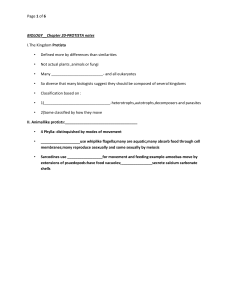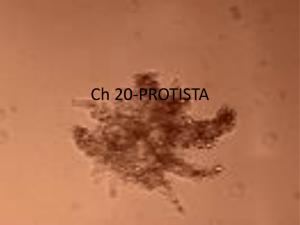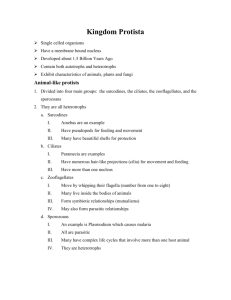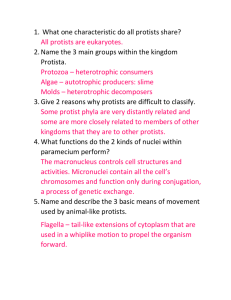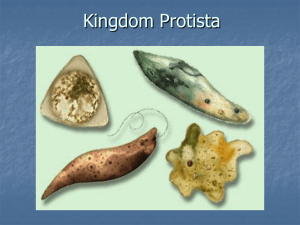Plantlike Protists
advertisement
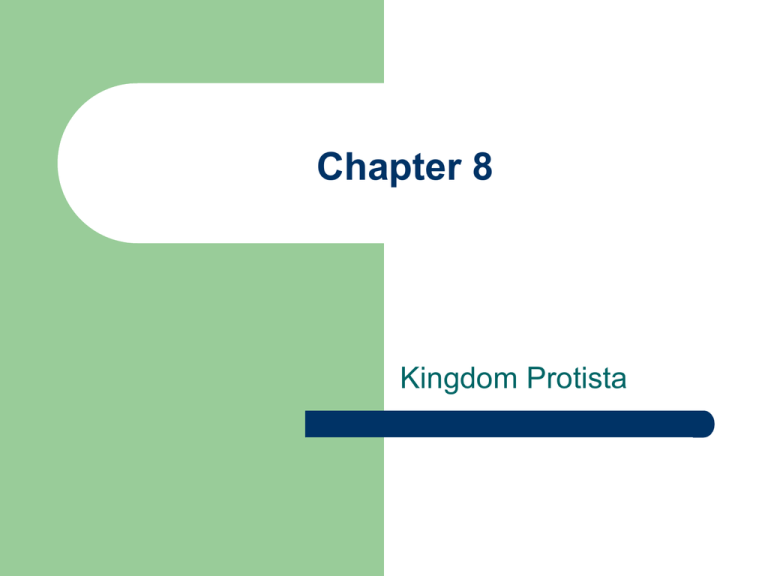
Chapter 8 Kingdom Protista Protist – a single or many celled organism that lies in moist or wet surroundings Eukaryotic Plant like Animal like Fungus like Some contain chlorophyll Some do not have chlorophyll Evolution of Protists Evolved from bacteria b/c they are more advanced than bacteria Cyanobacteria evolved into plantlike protists Protists are the ancestors of fungus, plants and animals Plantlike Protists Also known as algae Autotrophs Desmid Spirogyra, Pediastrum, a flat colony of green algae green algae is Volvox. a spherical colony. All the small cells of the colony possess two flagella and a small eyespot. colony is able to swim towards the light. Fucus - algae Brown seaweed Red seaweed algae Ulva – sea lettuce Euglena Single celled Characteristics of both plants and animals Plant – chlorophyll Animal – locomotion - flagella - no sun becomes heterotroph Eyespot – senses light Diatoms -unicellular -shell made of silica or glass w/ two parts that fit together snuggly -golden brown pigment that masks chlorophyll -when die sink to bottom of ocean Used in toothpaste and road lines Dinoflagellates - Armor made of cellulose Spinning flagellates - - - One flagella moves the cell One flagella circle the cell to spin it Unicellular Store food in form of starch and oils Live in salt water Food for saltwater organisms Red tide – over population of dino. produce toxins in water and kill organisms Animal like protists - protozoa One-celled Habitat: water, soil living and dead organisms Amoeba Pseudopods – “false feet” – Used for locomotion – Cytoplasmic streaming Used for feeding – Pseudopod forms around the food. This forms a vacuole. Amoeba with food vacuoles flagellates Protozoa that use flagellum Ex. Trypanosoma – – Responsible for African Sleeping Sickness ciliates Ciliates – Paramecium Slipper shaped Cilia – short hairs from cell membrane - used in locomotion - food getting Pellicle – outer skin Macronucleus – controls everyday activities Micronucleus – used in reproduction Oral groove – cilia sweep bacteria into this mouth Food vacuole forms Anal pore – waste vacuole removed Contractile vacuole – controls water in cell Trichocysts – anchor animal - capture food Paramecium Sexual reproduction of paramecium conjugation Overcrowding or environmental stress 2 paramecium line up side to side and exchange genetic material Micronucleus is exchanged Go on to binary fission Fungus like protists Live in moist soil and on decaying plants and trees Very colorful Move by forming pseudopods Feed on bacteria and other microorganisms Reproduce by spores Pretzel slime mold Yellow slime mold Dog vomit slime mold Slime mold on grass Water Molds Fuzzy white growths on decaying matter Grow as a mass of threads over a plant or animal and digest it Reproductive cells with flagella Have cell walls Water mold

